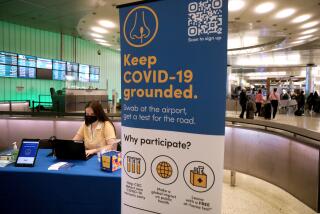A germ has a ticket to ride, and airlines can’t stop it
- Share via
The terror attacks of Sept. 11, 2001, alerted us to the fact that commercial airliners can be weapons. The recent spread of SARS reminds us that airliners can deliver far more than passengers, packages and duty-free knickknacks. They are a fast and efficient way to share germs.
“Within the known incubation period of any known agent, you can get from the rain forest to [Boston’s] Logan Airport in eight hours,” said Dr. David Ozonoff, chairman of the Department of Environmental Health at Boston University’s School of Public Health.
Humans have always moved and migrated with their illnesses. Air travel has accelerated the process. In one month, air travelers take about 130 million flights. But the speed at which a given germ can move through the air transport system depends on a number of factors -- from how catchy the bug is to whether it’s more likely to infect people on airplanes than in other public spaces.
Ozonoff says the “hub-and-spoke” airline “is made to order for these kinds of [disease] spreads.” The system brings lots of passengers together in large hub airports before shuttling them off to smaller “spoke” sites. For an easy-to-transmit illness like smallpox, this would be a recipe for a very rapid distribution.
Scholars at Johns Hopkins University in Baltimore, Md., created a computer model of the spread of smallpox via contagious airline passengers in the United States. In the case of smallpox, government officials would have only a few days to shut down the air travel system in order to staunch the spread of the disease, according to Hugh Ellis, a professor of environmental engineering at Johns Hopkins and one of the authors of the computer model. Ellis said it is not known whether a healthy individual is more likely to get sick during a plane ride than in another public setting.
Martha Waters, a research industrial hygienist with the National Institute for Occupational Safety and Health in Cincinnati, said airline passengers are in close quarters -- just as bus and subway riders are. But in airliners, she said, the air around them is moving much faster. Waters, who is part of a team that has been studying the airliner environment, said cabin air is a combination of fresh air and filtered, recycled air. She noted that the mix of fresh and recycled air -- and the kinds of filters used -- varies with the airplane model and with the airline itself.
Of course, a given passenger’s chances of getting an in-flight infection depend on a host of factors, including susceptibility and the way in which the particular illness is spread. Waters notes that sicknesses that spread via droplets -- like colds and, apparently, SARS -- certainly can be spread by a sneezing passenger to a seatmate. But that doesn’t mean that airplanes become flying hot zones.
“Would I take that any further and say that people shouldn’t get on airplanes?” Waters said. “Absolutely not.”
Health authorities around the globe already have intervened in the air travel system, notes Ozonoff, by alerting passengers traveling from SARS hot spots and encouraging citizens to put off nonessential travel to those areas. Some measures -- like the brief quarantine of a jetliner from Tokyo at the airport in San Jose, on April 1 -- may be too extreme. Ozonoff said that even the hint of smallpox elsewhere in the world would cause the severing of air links to that area. But SARS is neither as deadly nor as contagious as smallpox.
More to Read
Sign up for Essential California
The most important California stories and recommendations in your inbox every morning.
You may occasionally receive promotional content from the Los Angeles Times.













